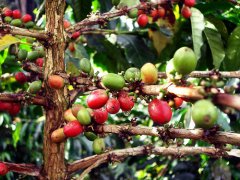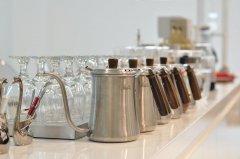Espresso production of Italian espresso with full-bodied beans
Boutique coffee (specialty coffee) is also called "specialty coffee" or "select coffee". It refers to coffee made from a small number of raw beans with excellent taste grown in an ideal geographical environment. Depending on the special soil and climatic conditions in which they grow, they have outstanding flavor. After strict selection and classification, this kind of coffee can be regarded as a selection of coffee beans because of its hard texture, rich taste and excellent flavor.
The idea of roasting coffee over fire probably came from Ethiopia in the 13th century. In the following 700 years, people did not make much improvement to the roasting techniques of coffee. At that time, most people baked coffee at home or in coffee shops and made coffee directly from freshly baked beans.
It was not until the mid-19th century that cylindrical coffee roasters were invented. From the beginning of baking with open fire to the current baking with gas or electricity, people are constantly innovating the design concept of the baking oven. In the 20th century, a modern industrial baking furnace was invented for the first time. At first, the roasters that people built were huge. Since then, the heat conduction system of the baking furnace has been improved. At that time, roasters cooked raw beans with fast-flowing hot air, while most of the industrial roasters we use today are flipped. The coffee is constantly flipped and heated evenly at a temperature of 240℃. After 8-20 minutes, the fragrant coffee beans are freshly baked.
In the process of coffee roasting, coffee undergoes a series of chemical reactions, and its color, taste and taste are constantly changing. Roasting can be said to be the most important part of the process of coffee from green raw beans to rich, mellow ripe beans.
Roasted coffee beans are crunchy, which makes grinding and extraction easier. The degree of roasting determines the color of coffee beans, but also affects the aroma, taste and so on. All in all, the time and degree of roasting determine the heaviest quality of coffee. In the coffee industry, we call the proportional relationship between all the variables that affect the final result of coffee roasting as "coffee roasting curve (Roasting Profile)".
As the roasting draws to a close, as soon as the color of the coffee meets your expectations, you must immediately cool the beans. Usually, coffee beans are cooled by the wind. In large-scale industrial production, coffee is cooled by water and then dried by wind. Perhaps many people do not realize that the cooling process of coffee will also have a great impact on the taste of coffee. The reason is very simple: the faster the cooling rate, the faster the internal roasting reaction of the coffee will end, and the aroma and taste of the coffee will be improved.
You may have seen bright, greasy coffee beans. This is due to the fact that the roasting time of coffee is very short and the degree is very deep. Too short a time and too much heat to wrap the oil in the coffee beans. After spilling, the oil cannot return to the coffee beans and solidifies on the surface of the coffee. This is what we often call "sweaty Sweating Coffee". The overflow of oil in coffee is caused by the strenuous movement of molecules and the expansion of gas in coffee. In addition, the shape of coffee beans, the pore structure of coffee beans, the viscosity of oil and atmospheric pressure will also affect this.
Important Notice :
前街咖啡 FrontStreet Coffee has moved to new addredd:
FrontStreet Coffee Address: 315,Donghua East Road,GuangZhou
Tel:020 38364473
- Prev

The reason for the high acidity and thinness of the taste is suitable for brewing coffee at home.
Boutique coffee (specialty coffee) is also called specialty coffee selection coffee. It refers to coffee made from a small number of raw beans with excellent taste grown in an ideal geographical environment. Depending on the special soil and climatic conditions in which they grow, they have outstanding flavor. After strict selection and classification, this kind of coffee is hard in texture, rich in taste and stylish.
- Next

Natural decaf coffee Laurina Swiss water treatment decaffeinated coffee boutique coffee
Boutique coffee (specialty coffee) is also called specialty coffee selection coffee. It refers to coffee made from a small number of raw beans with excellent taste grown in an ideal geographical environment. Depending on the special soil and climatic conditions in which they grow, they have outstanding flavor. After strict selection and classification, this kind of coffee is hard in texture, rich in taste and stylish.
Related
- Beginners will see the "Coffee pull flower" guide!
- What is the difference between ice blog purified milk and ordinary milk coffee?
- Why is the Philippines the largest producer of crops in Liberia?
- For coffee extraction, should the fine powder be retained?
- How does extracted espresso fill pressed powder? How much strength does it take to press the powder?
- How to make jasmine cold extract coffee? Is the jasmine + latte good?
- Will this little toy really make the coffee taste better? How does Lily Drip affect coffee extraction?
- Will the action of slapping the filter cup also affect coffee extraction?
- What's the difference between powder-to-water ratio and powder-to-liquid ratio?
- What is the Ethiopian local species? What does it have to do with Heirloom native species?

